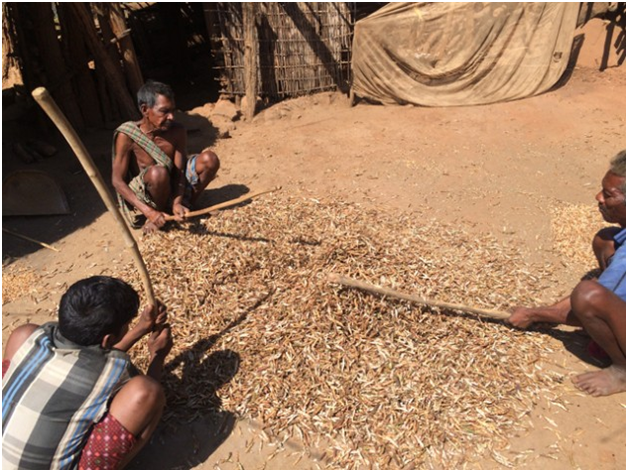TERI Students to the Rescue!

NEW DELHI/ROME(IPS) : As the seventh largest economy in the world by nominal GDP, India has fared better than many. Through a mix of interventions from the public and private sector, India’s economy has promoted growth and welfare. However, in spite of these developments, the challenge of hunger and malnutrition remain.
According to the assessment of countries’ performance of the MDG goals, India reported a decline in indicators such as the Poverty Head Count Ratio (PCHR) and the Poverty Gap Ratio (PGR) in both rural and urban areas. The country has in fact, fallen short of the targeted reduction of the proportion of underweight children. This is an indication of the future challenges to be overcome as India sets out to meet the new SDG target of zero hunger.
Throughout an academic year the students of the Masters Programme in Sustainable Development Practice at TERI University, New Delhi, India, who train in the skills required for adequate needs analysis and project design, visit several remote villages in India to identify core development issues. The students innovative research and cutting-edge initiatives are helping some villages in India to not only understand the meaning of sustainability but implement and achieve it too.
A male member of the tribal community carrying leaves from the forest for sale. While PGR is said to have declined, especially in the tribal and forested districts in India, many households are still dependent on forest produce. Forest produce at household level act as a source of building material, fuel, and food. The produce in the form of leaves, fruits, timber, and bamboo (especially tendu leaves for bidi making and sal leaf for plate making) helps support household income. There is a deep cultural association between the communities and the forests in many of these tribal pockets. This close connection places a strong emphasis on the protection of the forest from fire and any other adversity. Credit: Smriti Das
Students of the Masters Programme in Environment Science and Resource Management at TERI University learning tracks and signs as indicators of faunal diversity in a trek at Periyar Tiger Reserve, Kerala. The programme is an amalgamation of the science of environment and the management of natural resources. Credit: Smriti Das
Student and faculty of TERI University measuring trees. Their findings will be used to demonstrate that healthy ecosystems’ are core to climate adaption. Credit: Smriti Das
A Masters student from Bhutan analyzing a source of traditional ecological knowledge. The goal of sustainable forest management is achievable when scientific knowledge is combined with traditional ecological knowledge. Such convergence can result in sustainable and scientific approaches to the benefit of the forest and community. Credit: Smriti Das
A student educating women in rural Odisha on the importance of quality health services. While there has been a significant achievement in India in terms of reducing maternal and infant mortality, the global targets for 2030 require more attention for the development of sustainable healthcare. Credit: Smriti Das
Masters students evaluating resource use patterns with women stakeholders in rural Bhutan. The recognition of women as stakeholders in the economy will help meet the SDG 5 target of achieving equality and empowerment for all women and girls, particularly in rural communities where women have less access to information and resources. Credit: Smriti Das
Students assessing the changing resource use patterns presented to them by the locals of a Peri-Urban area of Haryana. While the SDG goal on Sustainable cities and the Government’s initiative of developing smart cities has had a positive impact in India, Peri-Urban areas are still vulnerable to the impacts of climate change , and declining resource productivity. Credit: Smriti Das
Masters course students who conducted quantitative and qualitative research on the resource conditions in Peri-Urban Haryana, share the data collected with villagers. Credit: Smriti Das
Teachers demonstrating the techniques of participatory research and planning to villagers. The development interventions in the village have been designed to address the requirements of the villagers by taking a hands-on approach and fully including them in the resource planning process. Credit: Smriti Das
Villagers in Odisha learning how to install solar equipment in a project steered by alumni of the masters programme. Innovative students of TERI University are trying to overcome one of the challenges posed by a lack of resources in the rural areas of India by providing reliable and affordable electricity to villages in the country. Credit: Smriti Das
A group discussion conducted by a faculty member of TERI University with farmers in Ganganagar, Rajasthan. TERI University’s field study in Rajasthan demonstrates how solar based irrigation systems can help enhance crop productivity in remote semi-arid areas all over the country. Credit: Smriti Das
Villagers discuss forest rights near Kumbalgarh Sanctuary in Rajasthan. The discussion centered on the study “Analyzing the implementation of Forest Rights Act (2006): a cultural political study of community rights in southern Rajasthan”, aimed at understanding how the landmark act, Scheduled Tribes and Other Forest Dwellers (Recognition of Rights) Act, 2006, is developing in the tribal belt of Rajasthan. Credit: Smriti Das
An elderly tribal couple, born and raised in the Rajasthan forest narrating their life story. Both vouch for the implementation of sustainable measures that will protect natural resources and leave a lasting impact on the future generations of forest dwellers. Credit: Smriti Das
(Cover Photo: A village in the Kalahandi district in the state of Odisha in India. The district still grapples with lack of basic amenities, low crop productivity, and malnutrition. The depleting harvest forces villagers to depend on other forms of manual labor. Credit: Smriti Das)



